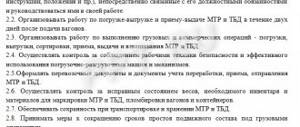Home / Labor Law / Employment / Hiring
Back
Published: 06/15/2016
Reading time: 8 min
0
8586
In addition to the main employees with whom the employer enters into open-ended or long-term employment contracts, many companies also have temporary employees. Most often, the need to hire them arises when the main employee takes maternity and child care leave.
Before accepting the position of a temporary employee during the period of maternity leave of the main employee, it is worth finding out what the maternity rate is and what the pros and cons of working under such conditions are.
- Concept and legislative regulation
- Advantages and disadvantages of working on maternity leave
- Disadvantages Short term
- Impossibility of establishing the exact date of validity of the employment contract
- Minimum protection of labor rights
- No guarantees
- Low requirements for the candidate
Legislative meaning of maternity rate
Many concepts related to the Labor Code are commonplace, but do not exist in modern legislative documents, for example, “maternity leave” and, accordingly, “maternity rate”. However, their meaning is usually clear to everyone, and they are strictly regulated by law, only under different terminological structures.
“Decree,” by analogy with the Soviet decree that gave a woman the right to maternity and child care leave, refers to two leaves associated with the birth of a child and caring for him, following one after the other. Accordingly, the maternity rate is the position that a woman held before going on maternity leave, to which she has the right to return at any time during or at the end of her maternity leave.
The legislation does not allow dismissing a pregnant woman or caring for a child under 3 years old (Article 256 of the Labor Code of the Russian Federation). Her place of work will be retained for her and await her return from leave, whenever it happens. During the absence of a permanent employee, the employer takes another person in her place, who will release him when the previous employee returns.
NOTE! Employment on maternity pay can only be temporary.
What it is?
There are situations when, when applying for a job, the head of the company informs the candidate that the position is maternity leave.
The main employee went on maternity leave and plans to return to her previous position at the end of this period. Not all citizens know what the maternity rate means. This definition should be understood as working at a temporarily free rate during the entire period while the main employee is at home with a small child.
The period of incapacity for work due to pregnancy and childbirth (BiR), according to Article No. 255 of the Labor Code of Russia, lasts at least 140 days. In the case of complicated births or multiple pregnancies, it will be longer. As a rule, a period of time off from work to care for a child immediately follows the labor leave. It can last 1.5 or 3 years.
In modern labor legislation there is no concept of “maternity pay”. It existed during the USSR period, but today it can also be heard often.
Two ways to “close” a maternity bet
To ensure the functioning of the position from which the main employee went on maternity leave, the employer has two possible ways. Each of them provides its own design nuances.
- Internal translation or combination . Sometimes management does not want to hire an outsider, preferring to distribute responsibilities among already working people. If labor functions do not contradict the qualifications of employees already working at the enterprise, then new responsibilities can be assigned to them on the basis of an additional agreement to the employment contract and an order from the manager. In this case, you do not need to enter anything into the work book; a note can be made on your personal card.
- Conclusion of a fixed-term employment contract . Occurs when a new employee is temporarily hired to fill a maternity position. In this case, an order for employment is necessary, as well as making an entry about it in the work book. A personal card must be created for a new employee, even if declared as temporary.
Features of registration of a temporary employee
Registration of a temporary worker in place of a maternity leaver has its own characteristics.
The head of the company needs to know about them in order to carry out the procedure in accordance with the requirements of labor legislation. The design involves:
- acceptance of an application addressed to the director of the company with a request for employment for a vacant position.
- consideration of the application and visa approval;
- preparation of documents necessary for registration of an employee, in accordance with Article No. 65 of the Labor Code of the Russian Federation. These include: SNILS, civil passport, work book, education document. Additionally, you may need: a driver's license, military registration document, police clearance certificate;
- issuance of an order for registration on maternity leave based on the application. It makes a note that the nature of the work is temporary;
- conclusion of a fixed-term employment contract in two copies. One option is given to the employee.
Temporary work is subject to labor legislation, local regulations, and internal regulations.
Mandatory clauses of a fixed-term contract for a maternity position
The text of such a document will be somewhat different from similar temporary employment, for example, for seasonal work or a short term.
As a rule, a fixed-term contract contains two dates - the beginning and end of cooperation. When employing an applicant on maternity leave, this cannot be done. The reason is that maternity leave includes two periods - leave related to pregnancy and childbirth (more precisely, sick leave) and leave to care for a small child, which an employee who has become a mother has the right to interrupt whenever she pleases.
Thus, the duration of work in a maternity position can be of varying lengths: from 140 days guaranteed by the state for preparation for childbirth and recovery after it, to 1.5 or 3 years old when the baby turns, if the mother intends not to rush to return to work and devote yourself to take care of your family.
To resolve this contradiction, the following way out is provided: in a fixed-term employment contract at a maternity rate, the expiration date is not considered to be a specifically defined date, but the event that has occurred - the return to the ranks of the employee, whom the temporary employee is called upon to replace.
Maternity leave under the new law
If a woman’s work experience is less than 6 months, then the amount of the benefit will be calculated based on the minimum wage. Its value in 2021 is 6,204 rubles. A woman will receive a benefit in the amount of: (6,204 * 24) / 730 * 140 = 28,555.40 rubles.
If a woman simultaneously acquires the right to receive care and pregnancy benefits (as in the case of adopting a newborn), then she can choose only one type of payment. If a woman does not go on vacation, but continues to work and receive a salary, then she loses the right to maternity benefits. An employer does not have the right to pay a woman both wages and benefits. If a woman has worked at her main place of work over the past two years, as well as part-time, then both employers must pay her benefits.
What if a temporary employee is also going on maternity leave?
Life is unpredictable, and it can often happen that a worker, called upon to replace a “maternity leaver” who is temporarily absent from work, is also planning to become a mother. In this case, everything will depend on the timing.
- If the main employee decides to leave her vacation before the pregnant woman replacing her receives a temporary disability certificate from the antenatal clinic, she will lose her job. The employer will dismiss the temporary worker, despite her pregnancy, on the basis of an event that determines the end of the contract.
- If the pregnancy of a person hired for a maternity position reaches 30 weeks, and the main employee continues to care for her baby, then the expectant mother will go on legally guaranteed maternity leave as calmly as her predecessor left. At the same time, she has every right to accrue payments due when going on maternity leave. Where to hire an employee now to take her place is the employer’s problem.
- If the main employee does not return from vacation for a long time, which will allow the woman hired in her place to bear, give birth to a baby and recover from childbirth within the 70 days required by law, then since she went on maternity leave while officially employed, she has the right to take leave and child care. She will be assigned appropriate payments and will maintain her seniority until the termination of the employment contract, that is, until she returns to her position as the first mother.
IMPORTANT INFORMATION! The last point is possible if the employer has nothing against it. By law, he has the right to fire a pregnant woman who replaced the main employee after giving birth, even if the event marking the end of the employment contract has not yet occurred. In this case, she will have to apply to the social security authorities for payments.
By agreement with the employer and with the written consent of the woman, she may be offered other vacancies in the company (if there are ones suitable for her qualifications), if it is planned to keep her on staff after the end of maternity leave.
How to transfer to the main position?
At the end of a fixed-term contract, an employee can be included in the personnel reserve.
This is what many employers do when they don’t want to lose a valuable employee. If a person performs well, he may get another position in the same organization. Now it all depends on your desire - to stay in your current job or look for another with better prospects. The transition from a temporary position to a main one is a fairly common practice. When the maternity leaver goes back to work, you will still have to quit. The employer will then ask you to write an application for a permanent position and enter into a traditional employment contract with you. The terms of the agreement and the amount of salary do not change.
Dismissal after maternity leave
An employer cannot terminate a contract with an employee on maternity leave on his own initiative. The only legal reason for dismissal is liquidation of the company. But if a girl decides to stop working at a specific place of work, she has the right to do so. This situation is regulated in Art. 81 Labor Code of the Russian Federation.
You must submit your application at your own request two weeks before the end of maternity leave. The dismissal of an employee is formalized in one day: there is no need to work the standard 14 days. Then a temporary worker can switch to a permanent position under absolutely legal conditions. According to Article 72 of the Labor Code of the Russian Federation, it is transferred automatically after the expiration of the fixed-term contract.
When replacing the main employee, a temporary employee must understand that this is a huge risk for him. No one can guarantee him permanent employment or social protection. But at the same time, a maternity position is an excellent option for starting. With its help, you can get a good position and demonstrate your abilities and talents.
Advantages and disadvantages of the maternity rate
Taking a temporary position related to the maternity leave of the main employee has both positive and negative aspects. Before agreeing to such a job, it is worth analyzing them.
Disadvantages of maternity pay
- The inherently transient nature of the work . When applying for a maternity position, a person must be aware that he will have to leave it.
- Unpredictability of deadlines . Since a “maternity leaver” has the right to be absent for either 140 days or more than three years, it is impossible to predict when the cooperation will end and plan further employment. If the term of the employment contract comes to an end, the employer may not even warn about the impending freedom in the usual two weeks: if the employee-mother returns to her position suddenly, the employee taken in her place will be fired on the same date.
- Minimum guarantees. Dismissal under this type of contract will not occur at the initiative of the employer, but due to circumstances that do not depend on the will of the parties: after all, the return of the main employee from maternity leave cannot be planned.
Such a reason for dismissal does not guarantee social protection and additional compensation payments: a pregnant woman, a single mother, or a person caring for a disabled person can be fired.Upon dismissal, such an employee will receive only regular wages and compensation for annual leave if he did not have time to use it.
- Insecurity in the event of one's own pregnancy . When working in a maternity position, a pregnant woman who has not managed to receive the coveted certificate of incapacity for work from the antenatal clinic can be mercilessly fired at any day without maintaining her seniority and assigning payments relying on the child.
Potential benefits of maternity leave
- Less stringent selection . A maternity vacancy is often a good chance to take a position that would otherwise be inaccessible to a candidate. Temporary work allows the employer to somewhat reduce the criteria for the experience, qualifications and personal qualities of the replacement employee. Often the time during which the employer must find a replacement also works for the applicant.
- New experience . While working on maternity leave, an employee acquires relevant skills that will be useful to him in future employment. Even if you take into account that the job is temporary, it may last long enough to get a job entry and the right to indicate additional experience in your resume.
- An opportunity to prove yourself . Temporary cooperation often represents a long probationary period, as a result of which management can decide on employment on a more secure basis. If there is a vacancy, it is more convenient and profitable for an employer to hire an already proven specialist than to select third-party people. In practice, most specialists who replace maternity leavers receive permanent work immediately or shortly after the departure of the main employee.
- Ordinary labor rights . A maternity rate is, although temporary, official employment with all the required guarantees: annual leave, the right to take sick leave, a salary not lower than the salary of the departing employee, and possibly receiving bonuses. While working in a maternity position, work experience follows the usual procedure.
How is it different from the usual one?
The maternity rate is different from the regular rate. It is important to compare these two concepts. The difference is quite significant and highlights all the advantages and disadvantages of each employment option. The differences and common features are shown in the table below.
| Comparison criterion | Maternity rate | Regular rate |
| Kind of work | Temporary | Constant |
| The need to document employment | Necessarily. A fixed-term contract is drawn up | Necessarily. An open-ended employment contract is concluded |
| How long will an employee be hired? | The contract is terminated immediately after the departure of the main employee. It is impossible to determine the exact duration of work | The employee is hired for an unlimited period. He can be dismissed at his own request, on the initiative of the employer or by agreement of the parties |
| Protection of labor rights | Minimum | Maximum |
| Salary amount | Similar to the main bet | Depends on the qualifications of the employee, characteristics and working conditions |
Fixed-term civil service contract and maternity leave
In accordance with Part 3 of Article 261 of the Labor Code, it is permissible to dismiss a woman due to the expiration of an employment contract during her pregnancy, if the employment contract was concluded for the duration of the duties of an absent employee and it is impossible, with the written consent of the woman, to transfer her to another existing job before the end of pregnancy the employer has a job (both a vacant position or work corresponding to the woman’s qualifications, and a vacant lower position or lower-paid job) that the woman can perform, taking into account her state of health. In this case, the employer is obliged to offer her all the vacancies that he has in the given area that meet the specified requirements. The employer is obliged to offer vacancies in other localities if this is provided for by the collective agreement, agreements, or employment contract.
The main provisions of the law Guarantees for pregnant women in relation to concluded contracts with the employer appear in Article 261 of the Civil Code of the Russian Federation. First of all, the contract with such an employee cannot be terminated due to the expiration of its validity period. The exception is situations when an enterprise or entrepreneur is in the process of liquidation.
Maternity leave
- A woman writes an application to her employer for maternity leave and benefits.
- The period for making a decision at the place of work on paying for vacation and calculating maternity benefits is generally 10 calendar days .
- A certain period of time is allotted for the transfer of money. The employer must transfer the funds on the first nearest day of payment of wages , along with wages to the rest of the employees.
- The employer (policyholder) initially pays money from his own funds , and only then the Social Insurance Fund reimburses him for the payment by reducing the payable insurance premiums and/or paying compensation.
- In some constituent entities of the Russian Federation, where the “Direct Payments” project operates, leave is paid to the woman directly from the territorial body of the Social Insurance Fund (although the application for maternity leave is still written to the employer, its calculation and payment is carried out by social insurance workers). In this case, the Social Insurance Fund has the right to pay for maternity leave until the 26th day of the month following the filing of the application for maternity leave.
The application is the main basis for starting maternity leave. It is written in free form and registered with the employer. There is no approved application form. Some information must be included in the document. These include:
How to fill out a bid
You can fill it out as follows.
- Provide employment for the main employee during maternity leave. The end date is not indicated; instead, the interval for which it is issued is indicated: for the period of waiting for the child and childbirth, caring for the baby until he turns 1.5, 3 years old.
- Perform a temporary transfer of an employee working in the organization until the maternity leaver returns to work. According to Art. 72.2 of the Labor Code of the Russian Federation, transfer to a maternity rate is permissible with the consent of the contracting parties, drawn up in writing. Based on the agreement, a transfer order is prepared. They do not enter the labor record.
It is possible to transfer a worker from one maternity rate to another only within the time interval for the first position. After the transfer is completed, the transferred person is given the previous position, otherwise the fixed-term employment contract is recognized as concluded permanently. If the term for a new job goes beyond the term for the first place, then the solution to the problem will be transfer through dismissal to a maternity rate. The employee must resign of his own free will or by agreement of the parties and re-enter under new conditions.
- Distribute absentee responsibilities among employees. The combination is formalized: an additional agreement is concluded, on the basis of which the personnel service prepares an order. There is no need to make a note in the work book.
Registration procedure
A sick leave certificate is required.
The rules for going on maternity leave from a permanent place and from a permanent one are the same.
- It is necessary to issue a sick leave certificate at the antenatal clinic where you are registered. You should contact your doctor for this. The sick leave certificate must be in the established format without errors or corrections. It contains exact numbers;
- Obtain a certificate of income for the two previous years in order to calculate the amount of payments. That is, if the maternity leave is in 2017, then the certificate indicates income for 2015-2016. The accounting department is responsible for preparing such a certificate. If the total work experience is less than six months, then such a document will not be needed, since when calculating the accountant they will take the minimum wage;
- Completing the application will complete the procedure. There is no established template for such a document.
All documents are sent to the management of the organization. The decision is made within no more than 10 days.
Maternity leave
If a woman is subject to compulsory social insurance in case of temporary disability and in connection with maternity, then the benefit assigned to her cannot be less than her average earnings , and even more so, cannot be lower than the minimum wage established by law (the minimum wage in 2021 is 11,280 rubles — this is the cost of living of the working-age population in Russia as a whole for the 2nd quarter of 2021).
- for 70 calendar days before the day of birth and for the same number of days ( 140 in total ) - after the birth of the baby;
- for 70 calendar days before the day of birth and for 86 days after the birth of the child ( 156 in total ) - if the birth was complicated;
- 84 days before the day of birth and 110 days after birth ( 194 in total ) - for the birth of two or more children (in case of multiple pregnancy).
26 Jul 2021 jurist7sib 95
Share this post
- Related Posts
- Mgou Lost Student Card
- Example of Simply Sanctions in Criminal Law
- What is the pension for the liquidators of the Chernobyl accident in Russia in 2021?
- Agreement on the Repayment of the Amount of Reduction in the Authorized Capital











